The History Of Mazda MPV

The Mazda MPV (Multi-Purpose Vehicle) is a minivan manufactured by Mazda. Introduced in 1989 as a rear wheel drive model, it was replaced in 2000 with a front wheel drive version. Over 1 million MPV models had been produced since its introduction.
The minivan boom of the 1980s caught the Japanese car makers by surprise. Each maker had its own response: Toyota was first with an adaptation of their mid-engined Van, based on the Japanese Town-Ace in 1984. Nissan and Mitsubishi quickly followed suit with conversions of cargo vans in 1987. All were small and only offered 4-cylinder engines.
The 1989 MPV was designed from the ground-up as a minivan for the American market. It was based on the large rear wheel drive 929's HC. It would be called the LV platform, and equipped the MPV with a V6 engine and optional four wheel drive. Its 4WD system is not to be confused with "all wheel drive"; the MPV can be switched into 4WD with a switch mounted on the column gear selector. A dash mounted switch also allowed the driver to lock the center differential, splitting power equally between the front and rear axles. The 4WD can be engaged and disengaged while moving.
Like the later Honda Odyssey, it featured traditional hinged doors instead of sliding rear doors, though the original MPV only had a single rear door. Because of the 4WD option, the Mazda Navajo (sold from 1991-1994) version of the Ford Explorer was only offered as a 2 door. The middle row was available as a bench, allowing seating for 8 when most minivans seated 7.
The van was named to Car and Driver magazine's Ten Best list for 1990 and 1991 and featured as one of their "vehicles for the coming (fuel) crisis". Initial sales were strong as well, but rapidly fell off once other makers introduced all wheel drive and V6 engines. However, Toyota's 1991 Previa, Nissan's 1993 Quest, and Honda's 1995 Odyssey all featured purpose-built platforms and eroded Mazda's lead.
The MPV received one star out of four in the Australian ANCAP crash tests and a "Marginal" rating in the American IIHS crash tests.
The van was refreshed in 1996, adding drivers' side rear door. While the I4 engine retired for the United States market, it was replaced with a similar 2.5L unit for the rest of the world. The '97 and '98 models received a mild refreshing with "all-sport" body cladding and wheel arches, and polished alloy wheels. Mazda discontinued the original MPV after the '98 model year.
-
-
- This generation was featured in the Wu-Tang Clan's C.R.E.A.M. video.
-
The MPV was replaced for 2000 with a front wheel drive LW platform based on the 626. This second generation MPV featured dual sliding rear doors,front-wheel drive, a third row seat that folded flat into the floor and rear door windows that rolled down.
The MPV initially used the Mazda AJ (which was actually Ford's Duratec) 2.5L V6, an engine initially designed by Porsche before it was sold to Ford and used in the Contour. A 4-speed automatic was standard.
The base DX model had a two-place middle bench seat. The LX model replaced the bench seat with two middle buckets (the passenger side seat could slide sideways, dubbed "side by slide"), power windows and locks, heated power mirrors, privacy glass, and antilock brakes. The ES model added leather seating surfaces, wood tone interior trim, side impact air bags on the front seats, bigger wheels, and separate front and rear air conditioners.
In model year 2001, all models added child-safety seat tether anchors. An optional GFX sport appearance package was made available for LX and ES models, which included fog lights and aero body add-ons. The 2001 model year ran long, extending into early 2002 in anticipation of the 2002 refresh.
In model year 2002, the MPV was refreshed with Mazda's AJ 3.0L V6, a 5-speed automatic transmission producing 200 hp and 200 ft·lbf of torque, a new grille featuring a single chrome bar at the top, power sliding side doors, revised suspension settings, and 17-inch alloy wheels.
In model year 2003, power operation of the side doors was made optional on the LX and ES. A base LX-SV model was added midway into the model year.
In model year 2004, it received a mild exterior and interior makeover. The exterior featured new headlights and Altezza style clear taillights. The interior changes included a new steering wheel, gauge surrounds, and a spring assist to ease folding the third row seat into the floor. The LX Sport package added body side skirts, anti-lock brakes, an air dam under the bumper, and an optional rear-mounted spoiler. The ES model added leather seats, rear air conditioner, power sliding doors, and a choice of moonroof or roof-mounted DVD player. No LX-SV model was offered.
In model year 2005, rear air conditioning became an optional feature on the LX (it had been standard on the LX in 2004).
In model year 2006, a base LX-SV model was again offered alongside the LX and ES models.
By 2006, the MPV was virtually the only minivan which had not adopted the size form factor of the long wheelbase Chrysler minivans, including Kia and Nissan.
The MPV was discontinued in both Europe and North America after 2006 as the smaller Mazda5 replaces it as Mazda's minivan. The MPV was also replaced in North America and Australia by the full-size Mazda CX-9 crossover SUV.
Engines:
- 2000-2001 2.0L FS-DE I4 (non-US)
- 2000-2001 2.5L GY-DE I4 (non-US)
- 2000-2001 2.5L AJ V6
- 2002-2006 3.0L AJ V6
- 2005-present 2.3L MZR 2.3 Direct Injecition Spark Ignition (DISI) Turbocharged I4 (non-US)
Price
Pricing for 2006 as follows:
- LX-SV:$22,115
- LX:$22,950
- ES:$28,515
On February 2, 2006, the third generation Mazda MPV went on sale in Japan as a model year 2007 car. It is powered by either a 4 cylinder MZR 2.3 naturally aspirated engine or 4 cylinder MZR 2.3 Direct Injection Spark Ignition (DISI) turbo engine.
The third generation MPV is currently available only in Japan, Hong Kong and some small number in Thailand
In 2008, facelifted version is introduced. External modifications include new front bumper with new fog-lights. 5-Speed Automatic is equipped in NA models. 6-Speed Automatics unchanged in Turbo models.
From Wikipedia, the free encyclopedia
More About Mazda MPV
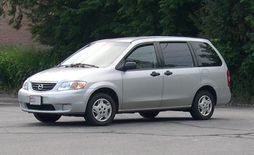
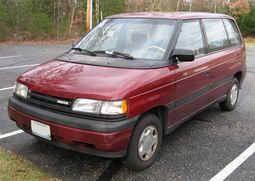


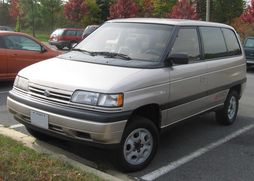

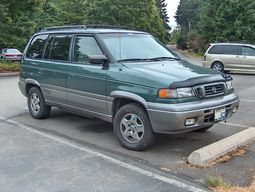


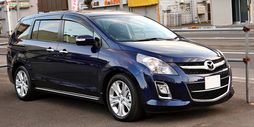
|